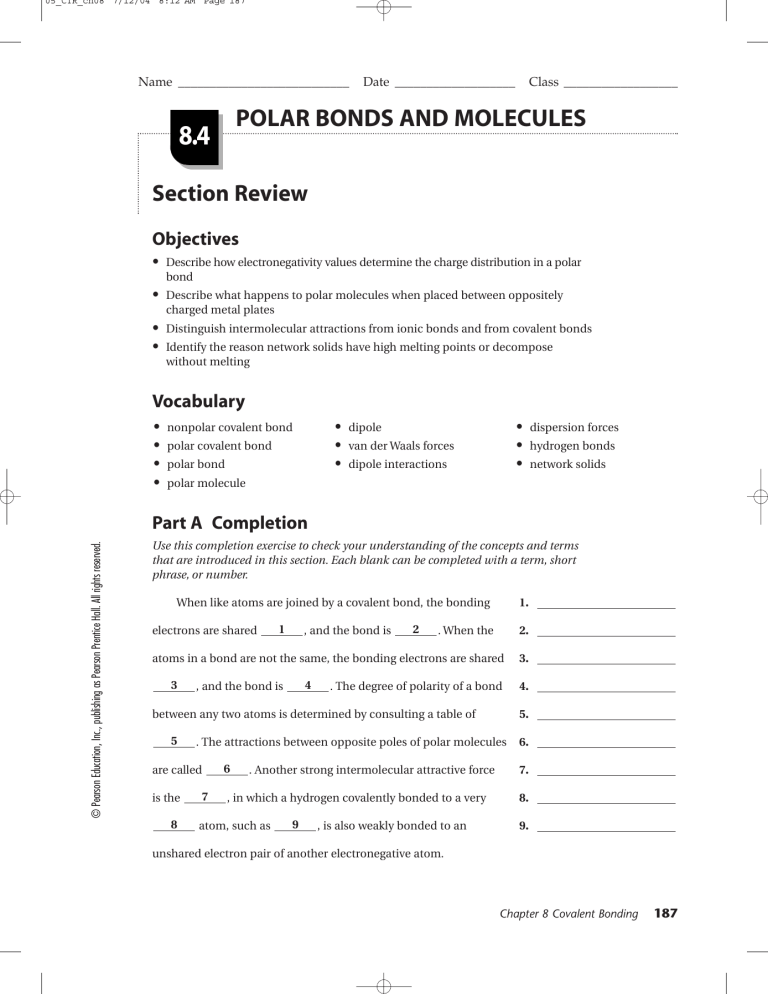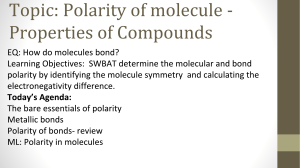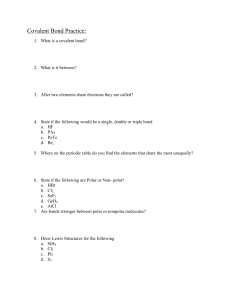
05_CTR_ch08 7/12/04 8:12 AM Page 187 Name ___________________________ Date ___________________ Class __________________ POLAR BONDS AND MOLECULES 8.4 Section Review Objectives • Describe how electronegativity values determine the charge distribution in a polar bond • Describe what happens to polar molecules when placed between oppositely charged metal plates • Distinguish intermolecular attractions from ionic bonds and from covalent bonds • Identify the reason network solids have high melting points or decompose without melting Vocabulary • • • • • dipole • van der Waals forces • dipole interactions nonpolar covalent bond polar covalent bond polar bond • dispersion forces • hydrogen bonds • network solids polar molecule © Pearson Education, Inc., publishing as Pearson Prentice Hall. All rights reserved. Part A Completion Use this completion exercise to check your understanding of the concepts and terms that are introduced in this section. Each blank can be completed with a term, short phrase, or number. When like atoms are joined by a covalent bond, the bonding electrons are shared 1 , and the bond is 2 1. . When the 2. atoms in a bond are not the same, the bonding electrons are shared 3 4 , and the bond is . The degree of polarity of a bond between any two atoms is determined by consulting a table of 5 is the 8 7 6 . Another strong intermolecular attractive force , in which a hydrogen covalently bonded to a very atom, such as 9 , is also weakly bonded to an 4. 5. . The attractions between opposite poles of polar molecules are called 3. 6. 7. 8. 9. unshared electron pair of another electronegative atom. Chapter 8 Covalent Bonding 187 05_CTR_ch08 7/12/04 8:12 AM Page 188 Name ___________________________ Date ___________________ Class __________________ Part B True-False Classify each of these statements as always true, AT; sometimes true, ST; or never true, NT. ________ 10. In a polar covalent bond, the more electronegative atom has a slight positive charge. ________ 11. In general, the electronegativity values of nonmetallic elements are greater than the electronegativity values of metallic elements. ________ 12. A molecule with polar bonds is dipolar. ________ 13. Covalent compounds are network solids. ________ 14. If the electronegativity difference between two atoms is greater than 2.0, they will form an ionic bond. ________ 15. Dispersion forces are weaker than hydrogen bonds. Part C Matching Match each description in Column B to the correct term in Column A. Column A Column B a. a substance in which all of the atoms are covalently bonded to each other ________ 17. polar covalent bond b. a bond formed when the atoms in a molecule are alike and the bonding electrons are shared equally ________ 18. polar molecule c. a term used to describe the weakest intermolecular attractions; these include dispersion forces and dipole interactions ________ 19. van der Waals forces d. a bond formed when two different atoms are joined by a covalent bond and the bonding electrons are shared unequally ________ 20. network solid e. a molecule in which one end is slightly positive and the other end is slightly negative 188 Core Teaching Resources © Pearson Education, Inc., publishing as Pearson Prentice Hall. All rights reserved. ________ 16. nonpolar covalent bond 05_CTR_ch08 7/12/04 8:12 AM Page 189 Name ___________________________ Date ___________________ Class __________________ Part D Questions and Problems Answer the following in the space provided. 21. Arrange the following intermolecular attractions in order of increasing strength: dipole interactions, dispersion forces, and hydrogen bonds. 22. State whether the following compounds contain polar covalent bonds, nonpolar covalent bonds, or ionic bonds, based on their electronegativities. a. b. SO2 b. c. NO2 c. d. Cl2 d. © Pearson Education, Inc., publishing as Pearson Prentice Hall. All rights reserved. a. KF Chapter 8 Covalent Bonding 189



